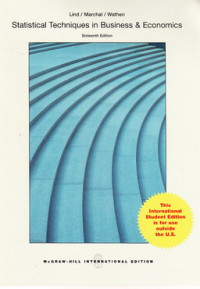Text
Statistical techniques in business and economics
Over the years, we have received many compliments on this text and understand that it's a favorite among students. We accept that as the highest compliment and con¬tinue to work very hard to maintain that status.
The objective of Statistical Techniques in Business and Economics is to provide students majoring in management, marketing, finance, accounting, economics, and other fields of business administration with an introductory survey of the many appli¬cations of descriptive and inferential statistics. We focus on business applications, but we also use many exercises and examples that relate to the current world of the col¬lege student. A previous course in statistics is not necessary, and the mathematical requirement is first-year algebra.
In this text, we show beginning students every step needed to be successful in a basic statistics course. This step-by-step approach enhances performance, ac¬celerates preparedness, and significantly improves motivation. Understanding the concepts, seeing and doing plenty of examples and exercises, and comprehending the application of statistical methods in business and economics are the focus of this book.
The first edition of this text was published in 1967. At that time, locating relevant business data was difficult. That has changed! Today, locating data is not a problem. The number of items you purchase at the grocery store is automatically recorded at the checkout counter. Phone companies track the time of our calls, the length of calls, and the identity of the person called. Credit card companies maintain information on the number, time and date, and amount of our purchases. Medical devices automati¬cally monitor our heart rate, blood pressure, and temperature from remote locations. A large amount of business information is recorded and reported almost instantly. CNN, USAToday, and MSNBC, for example, all have websites that track stock prices with a delay of less than 20 minutes.
Today, skills are needed to deal with a large volume of numerical information. First, we need to be critical consumers of information presented by others. Second, we need to be able to reduce large amounts of information into a concise and mean¬ingful form to enable us to make effective interpretations, judgments, and decisions. All students have calculators and most have either personal computers or access to personal computers in a campus lab. Statistical software, such as Microsoft Excel and Minitab, is available on these computers. The commands necessary to achieve the software results are available in Appendix C at the end of the book. We use screen captures within the chapters, so the student becomes familiar with the nature of the software output.
Because of the availability of computers and software, it is no longer necessary to dwell on calculations. We have replaced many of the calculation examples with inter¬pretative ones, to assist the student in understanding and interpreting the statistical results. In addition, we now place more emphasis on the conceptual nature of the statistical topics. While making these changes, we still continue to present, as best we can, the key concepts, along with supporting interesting and relevant examples.
Ketersediaan
Informasi Detail
- Judul Seri
-
-
- No. Panggil
-
650.021 Lin s
- Penerbit
- New York : Mc Graw-Hill., 2015
- Deskripsi Fisik
-
xxx, 830 hal. : il. ; 28 cm.
- Bahasa
-
English
- ISBN/ISSN
-
9781259095641
- Klasifikasi
-
650.021
- Tipe Isi
-
-
- Tipe Media
-
-
- Tipe Pembawa
-
-
- Edisi
-
Ed. XVI
- Subjek
- Info Detail Spesifik
-
-
- Pernyataan Tanggungjawab
-
-
Versi lain/terkait
Tidak tersedia versi lain
Lampiran Berkas
Komentar
Anda harus masuk sebelum memberikan komentar

 Karya Umum
Karya Umum  Filsafat
Filsafat  Agama
Agama  Ilmu-ilmu Sosial
Ilmu-ilmu Sosial  Bahasa
Bahasa  Ilmu-ilmu Murni
Ilmu-ilmu Murni  Ilmu-ilmu Terapan
Ilmu-ilmu Terapan  Kesenian, Hiburan, dan Olahraga
Kesenian, Hiburan, dan Olahraga  Kesusastraan
Kesusastraan  Geografi dan Sejarah
Geografi dan Sejarah